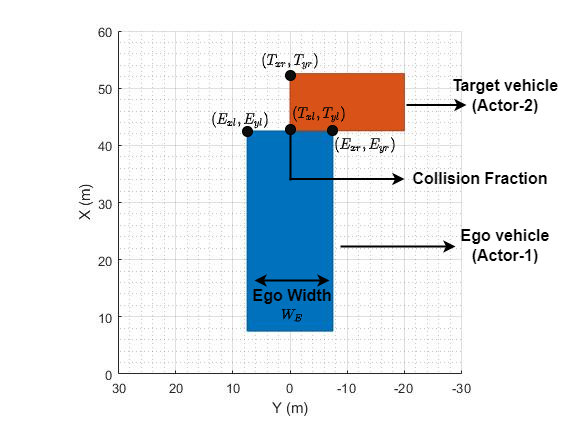getCollisionData
Syntax
Description
collisionInfo = getCollisionData(descriptor)descriptor.
collisionInfo = getCollisionData(descriptor,Name=Value)Actor1ID=2 checks for collision between the actor with the ID 2, and
all other actors in the scenario.
Note
This function requires the Automated Driving Toolbox™ Test Suite for Euro NCAP® Protocols support package. You can install Automated Driving Toolbox Test Suite for Euro NCAP Protocols from the Add-On Explorer. For more information about installing add-ons, see Get and Manage Add-Ons.
Examples
Load a driving scenario containing actor collision into the workspace.
load("scenarioWithSingleCollision.mat")Create a scenarioDescriptor object using the loaded driving scenario.
scenarioDescriptor = getScenarioDescriptor(sc,Simulator="DrivingScenario");Extract collision information from the scenarioDescriptor object.
collisionsInScenario = getCollisionData(scenarioDescriptor);
Display the extracted collision information.
disp(collisionsInScenario.Collision)
collision with properties:
Time: 0.4981
Point: [28.4345 4.0853]
Actor1Info: [1×1 struct]
Actor2Info: [1×1 struct]
Load a driving scenario containing multiple actor collisions into the workspace.
load("scenarioWithMultipleCollisions.mat")Create a scenarioDescriptor object using the loaded driving scenario.
scenarioDescriptor = getScenarioDescriptor(sc,Simulator="DrivingScenario");Extract collision information from the scenarioDescriptor object.
collisionsInScenario = getCollisionData(scenarioDescriptor);
Display the extracted information of first collision.
disp(collisionsInScenario(1).Collision)
collision with properties:
Time: 3.0102
Point: [30.5809 -1.0907]
Actor1Info: [1×1 struct]
Actor2Info: [1×1 struct]
Display the extracted information of second collision.
disp(collisionsInScenario(2).Collision)
collision with properties:
Time: 1.6756
Point: [1.1088 -1.1493]
Actor1Info: [1×1 struct]
Actor2Info: [1×1 struct]
Input Arguments
Scenario descriptor, specified as a ScenarioDescriptor object. The
ScenarioDescriptor object stores scene, actor, and vehicle
information extracted from a seed scenario, and uses this information to generate the
scenario variants. You can use these scenario variants to perform safety assessments for
various automated driving applications.
Name-Value Arguments
Specify optional pairs of arguments as
Name1=Value1,...,NameN=ValueN, where Name is
the argument name and Value is the corresponding value.
Name-value arguments must appear after other arguments, but the order of the
pairs does not matter.
Example: getCollisionData(D,Actor1ID=[2 3],Actor2ID=[5 6]) checks for
collisions of all possible pairs of the actors with IDs 2 and 3 and those with IDs 5 and
6.
First actor ID, specified as a positive integer or a row vector of positive integers.
If you do not specify Actor2ID, the function checks for
collision between each actor specified by Actor1ID and all other
actors in the scenario.
If you specify Actor2ID, the function checks collision for
all possible pairs between the actors specified by Actor1ID and
those specified by Actor2ID.
Data Types: single | double | uint8
Second actor ID, specified as a positive integer or a row vector of positive integers.
If you do not specify Actor1ID, the function checks for
collision between each actor specified by Actor2ID and all other
actors in the scenario.
If you specify Actor1ID, the function checks collision for
all possible pairs between the actors specified by Actor2ID and
those specified by Actor1ID.
Data Types: single | double | uint8
Output Arguments
Collision information between pairs of colliding actors, returned as an array of structures. Each structure in the array contains these fields:
Actor1ID— ID of the first colliding actor in the pair, returned as a positive integer.Actor2ID— ID of the second colliding actor in the pair, returned as a positive integer.Collision— Collision information, returned as acollisionobject. Thecollisionobject has these properties:Property Description TimeSimulation time at which collision occurs.
Units are in seconds.
PointCoordinates of the collision point in the world frame.
Units are in meters
Actor1InfoInformation about the first actor in the collision pair, returned as a structure.
Actor2InfoInformation about the second actor in the collision pair, returned as a structure.
Each
Actor1InfoandActor2Infostructure contains these fields:Field Description IDID of the corresponding actor, returned as a positive integer.
PositionPosition of the actor at the time of collision, returned as a three-element numeric row vector of the form [latitude longitude altitude].
Units are in meters.
SpeedSpeed of the actor at the time of collision, returned as a scalar.
Units are in meters per second.
Yaw(since R2024a)Yaw angle of the actor at the time of collision, returned as a scalar. Units are in radians.
CollisionFractionPoint of collision relative to the collision side of the actor, returned as a fraction in the range [0, 1]. For more information, see Collision Fraction.
CollisionSideSide of the actor at which collision occurs, returned as
Front,Left,Back, orRight.
Note
If the input scenario contains no collisions, or no collisions between the
specified pairs of actors Actor1ID and
Actor2ID, the function returns
collisionInfo as an empty array,
[].
More About
The collision fraction specifies the relative position on the
collision side of a vehicle at which the collision occurs. For example, if the center of the
front edge of the ego vehicle Actor-1 collides with the left corner on
the front edge of the target vehicle Actor-2, then the collision fraction
of Actor-1 is 0.5.

Collision fraction is defined by the equation
where Exl and Eyl are the x- and y-coordinates of the left corner of the ego vehicle collision side, Txl and Tyl are the x- and y-coordinates of the collision point on the target vehicle, and WE is the width of the collision side of the ego vehicle.
Version History
Introduced in R2023aThe output Actor1Info and Actor2Info structure now
includes an additional Yaw field, specifying the yaw angles of the actor
at the time of collision.
See Also
MATLAB Command
You clicked a link that corresponds to this MATLAB command:
Run the command by entering it in the MATLAB Command Window. Web browsers do not support MATLAB commands.
Web サイトの選択
Web サイトを選択すると、翻訳されたコンテンツにアクセスし、地域のイベントやサービスを確認できます。現在の位置情報に基づき、次のサイトの選択を推奨します:
また、以下のリストから Web サイトを選択することもできます。
最適なサイトパフォーマンスの取得方法
中国のサイト (中国語または英語) を選択することで、最適なサイトパフォーマンスが得られます。その他の国の MathWorks のサイトは、お客様の地域からのアクセスが最適化されていません。
南北アメリカ
- América Latina (Español)
- Canada (English)
- United States (English)
ヨーロッパ
- Belgium (English)
- Denmark (English)
- Deutschland (Deutsch)
- España (Español)
- Finland (English)
- France (Français)
- Ireland (English)
- Italia (Italiano)
- Luxembourg (English)
- Netherlands (English)
- Norway (English)
- Österreich (Deutsch)
- Portugal (English)
- Sweden (English)
- Switzerland
- United Kingdom (English)